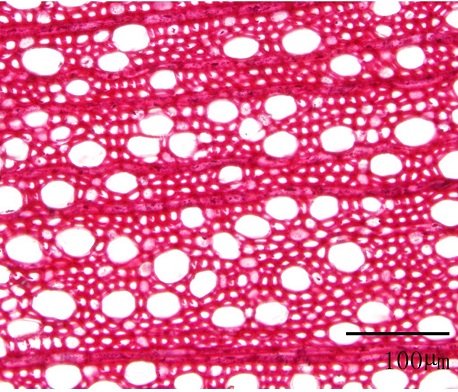

中国3个主要梨砧木资源木质部导管分子结构及分布比较
? 共同第一作者
收稿日期: 2014-03-20
录用日期: 2014-08-25
网络出版日期: 2015-04-10
基金资助
公益性行业(农业)科研专项(No.201003021)和国家自然科学基金(No.31272128)
Comparison of the Characters and Distribution of Vessel Elements in Xylem Among Three Main Pear Rootstocks in China
? These authors contributed equally to this paper
Received date: 2014-03-20
Accepted date: 2014-08-25
Online published: 2015-04-10
采用组织离析法、石蜡切片法和显微照相技术, 观测了山梨(Pyrus ussuriensis)、杜梨(P. betuleafolia)和豆梨(P. calleryana)3种我国最主要梨属砧木茎干部位导管分子结构及分布。结果表明, 3种梨砧木导管分子结构在侧壁次生增厚和木质化的方式、纹孔式、主要穿孔板类型, 以及端壁倾斜、尾有无、尾长短分布趋势基本一致, 但山梨、杜梨复穿孔板比例、两端端壁倾斜比例高于豆梨。豆梨导管分子直径显著高于山梨和杜梨; 山梨和杜梨导管频率显著高于豆梨。木质部比导率测定结果显示, 豆梨显著高于山梨和杜梨, 山梨与杜梨间无显著差异。因此, 不同生境下的梨属植物木质部导管分子形态及分布与其生态适应性之间有较强的相关性, 表现为南方温暖潮湿环境起源的梨砧木导管较短, 直径较宽, 直接影响木质部导水率, 从而适于水分高效输导; 北方寒冷干旱环境起源的梨砧木导管较长, 直径较小, 导水能力低, 但木质部导管分布密度高, 利于水分安全输导。

王昆 , 田路明 , 张莹 , 董星光 , 曹玉芬 , 齐丹 . 中国3个主要梨砧木资源木质部导管分子结构及分布比较[J]. 植物学报, 2015 , 50(2) : 227 -233 . DOI: 10.3724/SP.J.1259.2015.00227
The characteristics and distribution of vessel elements in xylem of three main pear rootstocks (Pyrus ussuriensis, P. betuleafolia, P. calleryana) in China were examined by tissue isolation, paraffin sectioning and biometric statistics. The pattern of secondary wall thickening and lignification, pitting pattern, main types of perforation plates and proportion of tail, end walls, and tail length of vessel elements did not differ among the species. However, the proportion of vessel elements with multiperforate perforation and two tapered end walls and vessel frequency were higher in P. ussuriensis and in P. betuleafolia than P. calleryana. The diameter of vessel elements and specific conductivity were higher in P. calleryana than in P. ussuriensis and P. betuleafolia. Morphological structure and ecological adaptability are correlated in Pyrus varieties in different habitats. The vessel elements of pear rootstock species from south China are shorter in length and broader in diameter, which appears to directly affect hydraulic conductance capacity and therefore may be suitable for conducting water with high efficiency. The vessel elements of pear rootstock species from north China are longer in length and smaller in diameter with higher vessel frequency, which may help for conducting water safely.

| 1 | 白重炎, 高巨营, 张朝 (2011). 13种核桃茎的解剖结构与其抗寒抗旱性研究. 安徽农业科学 39, 16496-16498, 16502. |
| 2 | 陈树思 (2006). 洋蒲桃次生木质部中导管分子的解剖学. 植物学通报 23, 677-683. |
| 3 | 董星光, 田路明, 曹玉芬, 张莹 (2012). 我国南方优势产区梨品种主要品质性状评价. 西南农业学报 25, 1811-1817. |
| 4 | 杜中军, 翟衡, 潘志勇, 解秀芹 (2001). 盐胁迫下苹果砧木光合能力及光合色素的变化. 果树学报 18, 200-203. |
| 5 | 杜中军, 翟衡, 罗新书, 潘志勇, 程述汉 (2002). 苹果砧木耐盐性鉴定及其指标判定. 果树学报 19, 4-7. |
| 6 | 樊卫国, 李迎春 (2007). 部分梨砧木的叶片组织结构与抗旱性的关系. 果树学报 25, 17-21. |
| 7 | 郭学民, 肖啸, 梁丽松, 张立彬, 高荣孚, 王贵禧 (2011). ‘21世纪’桃对其砧木毛桃根系导管分子性状的影响. 园艺学报 38, 1147-1152. |
| 8 | 李国秀, 郑宝江 (2014). 10种茶藨子属植物导管分子形态特征及其生态适应性比较研究. 植物研究 34, 25-31. |
| 9 | 李红芳, 田先华, 任毅 (2005). 维管植物导管及其穿孔板的研究进展. 西北植物学报 25, 419-424. |
| 10 | 李六林, 杨佩芳, 田彩芳 (2000). M系、山定子砧及红星苹果枝条次生木质部组织解剖研究. 见: 中国园艺学会第四届青年学术讨论会论文集. 北京: 中国园艺学会. |
| 11 | 李正理 (1996). 植物组织制片学. 北京: 北京大学出版社. pp. 91-92. |
| 12 | 刘和, 杨佩芳, 牛吉山, 高美英 (1996). 杏李次生木质部导管分子的解剖学研究. 山西农业大学学报 16, 404-407. |
| 13 | 王明浩, 张晓玮, 王婧如, 赵长明 (2013). 一种简易准确测定木质部导水率的新方法. 植物生理学报 49, 297-300. |
| 14 | 王中英, 杨佩芳, 解思敏, 古润泽 (1993). 梨属果树不同树种的解剖学研究. 落叶果树 (4), 9-11. |
| 15 | 肖啸, 郭学民, 刘建珍, 张立彬 (2012). 桃3种砧木次生木质部导管分子性状比较. 果树学报 29, 171-176. |
| 16 | 俞诚鸿 (1954). 次生木质部的进化与植物系统发育的关系. 植物学报 3, 183-194. |
| 17 | 张大维 (2004). 东北桦木科植物比较解剖学研究. 博士论文. 哈尔滨: 东北林业大学. |
| 18 | 郑国锠 (1978). 生物显微技术. 北京: 人民教育出版社. pp. 17-92. |
| 19 | 朱俊义 (2002). 花楸(Sorbus pohuashanensis)导管分子穿孔板的类型及演化. 植物研究 22, 285-288. |
| 20 | Carlquist S (1988). Comparative Wood Anatomy.Berlin: Springer-Verlag. pp. 41-81. |
| 21 | Hajagos A, Végvári G (2012). Investigation of tissue structure and xylem anatomy of eight rootstocks of sweet cherry (Prunus avium L.).Trees 27, 53-60. |
| 22 | Hosokawa M, Suzuki S, Umezawa T, Sato Y (2001). Progress of lignification mediated by intercellular transportation of monolignols during tracheary element differentiation of isolated Zinnia mesophyll cells.Plant Cell Physiol 42, 959-968. |
| 23 | Lo Gullo MA, Salleo S, Piaceri EC, Rosso R (1995). Relations between vulnerability to xylem embolism and xylem conduit dimensions in young trees of Quercus cerris.Plant Cell Environ 18, 661-669. |
| 24 | Pennel RI, Lamb C (1997). Programmed cell death in plants.Plant Cell 9, 1157-1168. |
| 25 | Solari LI, Johnson S, DeJong TM (2006). Hydraulic conductance characteristics of peach (Prunus persica) trees on different rootstocks are related to biomass production and distribution.Tree Physiol 26, 1343-1350. |
| 26 | Tippo O (1941). A list of diagnostic characteristics for descriptions of dicotyledonous woods.Trans Illinois Acad Sci 34, 105-106. |
| 27 | Tombesi S, Johnson RS, Day KR, DeJong TM (2010). Relationships between xylem vessel characteristics, calculated axial hydraulic conductance and size-controlling capacity of peach rootstocks.Ann Bot 105, 327-331. |
| 28 | Zimmermann MH (1983). Xylem Structure and the Ascent of Sap. Berlin: Springer-Verlag. pp. 143. |
/
| 〈 |
|
〉 |